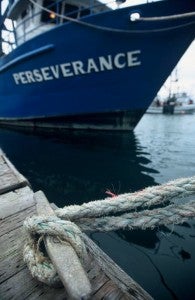Catch Shares Address Community Impacts in Ways Conventional Fisheries Management Cannot
 All fishing communities have one thing in common: they depend on healthy, productive fish stocks. Catch share management programs benefit fishing communities by helping to stabilize fisheries. Fishing is inherently unpredictable, because it depends so much on ever-changing conditions in the oceans. Since well-designed catch share systems give fishermen more flexibility to time their fishing activities, they are significantly better than traditional management methods at helping fishermen cope with negative fluctuations in barometric readings or in dock prices paid for the fish they deliver.
All fishing communities have one thing in common: they depend on healthy, productive fish stocks. Catch share management programs benefit fishing communities by helping to stabilize fisheries. Fishing is inherently unpredictable, because it depends so much on ever-changing conditions in the oceans. Since well-designed catch share systems give fishermen more flexibility to time their fishing activities, they are significantly better than traditional management methods at helping fishermen cope with negative fluctuations in barometric readings or in dock prices paid for the fish they deliver.
Well-designed catch share systems also include tools and mechanisms that benefit communities, things you won’t find under traditional management.
Over the years, thousands of fishing jobs have been lost due to declining fishing opportunities. Under conventional management, fishermen face ever-increasing limits on harvest levels, and shorter and shorter fishing seasons. When fishing is allowed, conventional management often forces fishermen into a dangerous and inefficient race for fish.
One example; in the days before catch shares, the West Coast trawl fishery was on a downward economic spiral. Processing plants were shuttered, infrastructure was lost, and ports became shadows of their former selves. It was death by a thousand cuts – with extended fishery closures, a federal disaster declaration, dwindling trip limits, and ever-decreasing annual catch limits, fishermen were leaving the industry and the coastal communities that relied on groundfish landings were spiraling downward. Under status quo management in place at the time, a handful of major players bought up permits and consolidated ownership. This meant even fewer owner-operators on the water.
By contrast, the catch share program that went into place in 2011 for the groundfish fishery includes fair allocation, limits on consolidation of fishing rights, and opportunities for new entrants. Those elements directly benefit coastal communities and the small businesses that support fishermen.
Specifically, the Pacific groundfish catch share program includes:
- Strict ownership caps for each species, to ensure that no individual fishermen or entity can accumulate excessive amounts of quota. There are also caps on the amount of species quota that any entity can control through business arrangements.
- An Adaptive Management Program designed to stabilize fishing communities and maximize benefits of the program while protecting against unanticipated consequences. For example, the adaptive management quota could help traditional fishing ports maintain access to landings of groundfish. The program would set aside 10% of the trawl total allowable catch and dedicate it to a public trust pool.
- In addition, the Pacific Fishery Management Council is has authorized community fishing associations and collective fishing arrangements to hold quota. These entities will provide communities with the opportunity to maintain access to groundfish, opportunities that do not exist under status quo management.
- Opportunities for new entrants – Quota is divisible down to the single pound level, meaning that young fishermen can buy in gradually, accumulating small amounts of quota. As other fishermen leave the fishery, permits will become available for purchase. In addition, quota from the Adaptive Management Program mentioned above could be leased or loaned to new entrants to enable them to enter the fishery at reduced cost.
Status quo management failed to make fishing profitable for West Coast fishermen who rely on groundfish. This in turn put fishing communities in danger, and catch shares came at a time when fishing ports were extremely vulnerable. Catch shares provide the means for communities to benefit from a productive and renewed fishing fleet. The Pacific groundfish catch share program demonstrates that there are ways to protect communities, smaller operators, and new entrants, while still providing for economic stability and the sustainability of the fishery overall.










